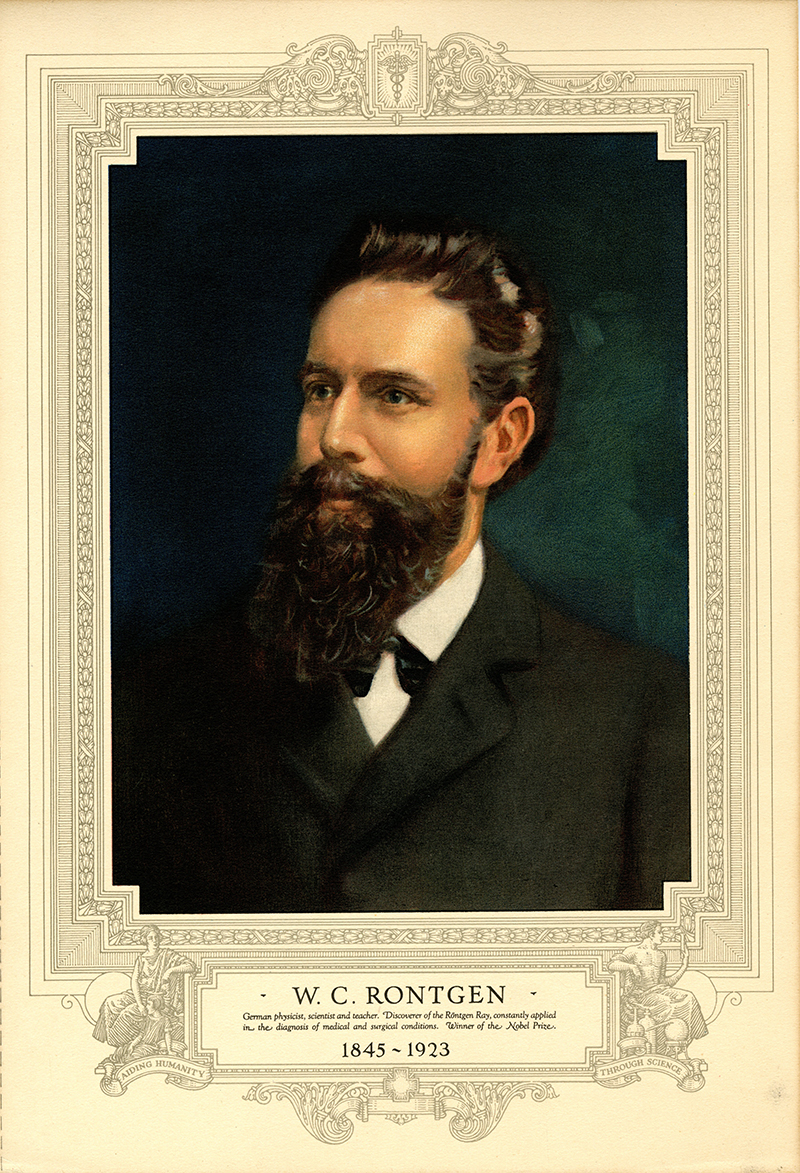“Eine neue art von strahlen.” [In: Sitzungsberichten der Würzburger Physik-medic. Gesellschaft. 1895] Würzburg, Stahel, 1895.
“Eine neue art von strahlen. II. Mittheilung.” [In: Sitzungsberichten der Würzburger Physikal-medic. Gesellschaft…]. Würzburg, Stahel, 1896.
“On a new kind of rays.” [In] Nature, v. 53, no. 1369, January 23, 1896. London, 1896.
 Near the end of the 19th century, there was an innovation which proved to be instantly useful in medical diagnosis, and eventually showed its value in treatment and therapy too. This new device was called the x-ray by its discoverer, Wilhelm Conrad Röntgen, but other scientists called it the Röntgen ray out of respect. Though born in Lennep in the Rhine Province of Germany, Röntgen spent most of his childhood in Holland. As a student, he did not excel, and his opportunities were further limited by his expulsion from one school for not snitching on a classmate. However, this all changed when he began studying mechanical engineering at the Polytechnic in Zurich, and even more so when he became an assistant to the professor of physics, August Kundt. Thanks to the help of this mentor, and to Röntgen’s own hard work in publishing, he held several respected academic positions before his ground-breaking discovery (Dict. Sci. Bio., Vol. 11 & 12, p. 529).
Near the end of the 19th century, there was an innovation which proved to be instantly useful in medical diagnosis, and eventually showed its value in treatment and therapy too. This new device was called the x-ray by its discoverer, Wilhelm Conrad Röntgen, but other scientists called it the Röntgen ray out of respect. Though born in Lennep in the Rhine Province of Germany, Röntgen spent most of his childhood in Holland. As a student, he did not excel, and his opportunities were further limited by his expulsion from one school for not snitching on a classmate. However, this all changed when he began studying mechanical engineering at the Polytechnic in Zurich, and even more so when he became an assistant to the professor of physics, August Kundt. Thanks to the help of this mentor, and to Röntgen’s own hard work in publishing, he held several respected academic positions before his ground-breaking discovery (Dict. Sci. Bio., Vol. 11 & 12, p. 529).
While rector and director of the Institute of Physics at the University of Würzburg, Röntgen experimented with the Crookes tube, a vacuum that interested him because of its usefulness in the study of electricity. He noticed by accident that the tube produced shadows of objects on a photographic plate. But it was through carefully planned experimentation that he showed how the same process done to a light-proof tube results in a kind of ray that passes through the soft parts of the body, revealing internal bones and organs (Clendening 666; Garrison 721). Quickly, Röntgen revealed his discovery to the Würzburg Society by presenting a paper entitled “Eine neue art von strahlen,” which translates into English as “On a new kind of rays.” Attending the presentation was the respected histologist, Rudolph Albert von Kölliker, who volunteered to have an x-ray of his hand made. The demonstration impressed all attendees, and Kölliker’s suggestion of the term Röntgen ray was well received. The society published the paper in its journal for December 1895. The Reynolds-Finley has a boxed set including two copies of the first publication of the paper, and one copy of a follow-up paper published in the same journal. Potential medical uses of the x-ray were instantly recognized. Some of the earliest benefits concerned orthopedics and diagnosis of chest difficulties (Cambridge 140-1). News spread throughout the world, and the paper was quickly translated into many languages. The Reynolds-Finley has a copy of the 1896 English translation from the journal Nature. Röntgen’s great discovery earned him the Nobel Prize for Physics in 1901, and many scholars hold this technology as the most influential to medicine (Duffin 202).
Cambridge Illus. Hist. Med., pp. 140-141; Clendening, Source Book of Med. Hist., p. 666; Dict. Sci. Bio., Vol. 11 & 12, p. 529; Duffin, Hist. of Med., p. 202; Garrison, Hist. of Med. 4th Edition, p. 721; One Hund. Books, 83; Reynolds Historical Library, Rare books and coll., 3584, 3585 & 3590.
Image: Wilhelm Conrad Rontgen, Print Collection, Reynolds-Finley Historical Library.
